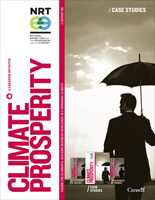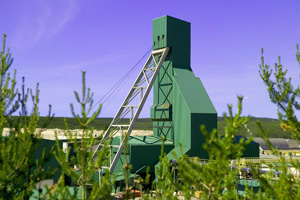Cameco Corporation – Case Study
FACING THE ELEMENTS: Building Business Resilience in a Changing Climate
|
“Overall the potential climate change benefits outweigh the potential drawbacks.”– Shane Borchardt, Program Manager, Environmental Systems, Cameco |

|
AT A GLANCE // |
Location:Saskatoon, Saskatchewan Industry:Chemical manufacturing Employees (2011):3,500 worldwide Revenue (2010):C$2.12 billion Total uranium production (2010):22.8 million lbs (Cameco’s share) |
Key adaptation
|
Adaptation
|
Business Benefits
Increased confidence in risk management among senior management |
Business ChallengesLack of government incentives |
COMPANY OVERVIEW //
SASKATOON, SASKATCHEWAN
www.cameco.com

McArthur River mining facility
(photo credit: Cameco Corporation)
Since 1975, known uranium resources have increased almost threefold because of higher investment in exploration.2 As nuclear power generation produces negligible greenhouse gas (GHG) emissions, uranium companies could benefit from increased demand for nuclear energy as an alternative to fossil fuels, particularly as developing countries’ economies continue to grow and targets to reduce GHG emissions become more stringent.
MINING IN A CHANGING CLIMATE
Most of the climate risks faced by Cameco as a uranium producer come from its mining activities, which are often undertaken in isolated environments with harsh and challenging climates. Mining operations are directly exposed to the impacts of a changing climate because of their reliance on long-lived and capital-intensive assets, their extensive transportation networks and long supply chains. The International Council on Mining and Metals (ICMM) recognizes climate change as a significant issue, and encourages its members to develop appropriate adaptation strategies specific to operations.3
Rising temperatures, projected to be particularly pronounced during the winter in the Far North, will affect access to resources on winter roads, for example. These roads depend on the structural integrity of the underlying frozen base material, and observed trends have already shown a substantial reduction in the duration of the winter-road season over the past 30 years.4 Water-intensive mining and milling activities could also be affected by future changes in the seasonal distribution of precipitation; this is particularly critical in locations where seasonal water scarcity is already a constraint.
With climate change, the frequency and severity of extreme weather events (such as storms, droughts and flooding) and other disturbances are expected to increase, with knock-on costs and potential for downtime and disruption of mining operations. For example, increased risk of forest fires in the Prairies due to hotter temperatures and reduced summer precipitation could result in increased costs for fire risk management, particularly in remote locations that do not benefit from publicly-funded firefighting services.
Finally, climate change has the potential to complicate the safe, long-term decommissioning of assets, a process that is critical for the mining industry.
DRIVERS
Cameco created an Environmental Leadership team in 2006, part of a concerted effort to become a forerunner in understanding and managing the environmental issues facing the industry. The Environmental Leadership team’s mandate includes scanning and studying environmental challenges that have the potential to become company liabilities, in order to incorporate them into the corporate risk assessment system if warranted.
Climate change (both the reduction of GHG emissions and physical impacts of a changing climate) was identified early on as a potential company risk issue, because of its importance in public policy debates and the media. Cameco’s Environmental Leadership team also felt that the company should join the large number of companies across a broad range of sectors that had started considering climate change risks and opportunities.
A FOCUS ON RISK ASSESSMENT
In 2008, as a first step in managing the corporate risks of climate change, the Environmental Leadership team conducted a climate change risk assessment by coordinating working group discussions with staff from different divisions of the company. This exercise was facilitated by an external consultant from Acclimatise, a specialist climate risk management consultancy.
In addition to considering the implications of climate change for the company as a whole, a small number of individual Cameco facilities (which represented a range of geographies and business areas) were selected for this exercise:
// a high-grade uranium mill in Key Lake (Saskatchewan) and an in situ recovery operation (Joint Venture Inkai) in a remote part of Kazakhstan represented the company’s mining division, and
// a uranium refinery at Blind River (Ontario) represented the fuel and power division.
The climate change risk assessment conducted by Cameco followed a well-known framework for making decisions in the face of climate change uncertainty.5 Four working groups considered a broad range of climate change risks and opportunities, including the potential need for higher amounts of cooling water, increased fire risk, higher road maintenance costs, and possible supply chain disruptions.
The most significant risk identified by Cameco was reduced water availability for operations in Kazakhstan, as a result of projected increases in temperature and decreases in precipitation. The assessment also concluded that climate change could affect water quality, with knock-on consequences for local communities, which could be attributed to Cameco’s operations.
Overall, the climate risk assessment found that for the majority of Cameco’s operations the benefits of climate change (which include increased demand for uranium and nuclear energy due to GHG emission targets, as well as savings associated with reduced heating requirements) are likely to outweigh potential risks. As a result, climate change is not considered to be an enterprise risk and no specific management measures were put forward. Responsibility for climate risk management currently sits with individual site managers.
The results of Cameco’s climate risk assessment formed part of the company’s response to an annual request for information from the Carbon Disclosure Project, which represents 551 institutional investors.
BENEFITS AND/OR CHALLENGES
The comprehensive climate risk assessment exercise conducted in 2008 has provided senior management with the confidence that no hidden liabilities exist because of climate change. The assessment has also helped the company to improve its communication with stakeholders on climate change risks and opportunities.
Formal government incentives or obligations would prompt action at the site level that might otherwise not have been undertaken.
NEXT STEPS
Cameco will continue to monitor possible risks and opportunities at a high level, especially in connection with communication and investor relations, so long as climate change remains a high profile issue in the public realm. However, unless new information showing considerable underor overestimation of future changes in climate becomes available, there is no plan to update the results of Cameco’s climate change risk assessment.
In countries where legislation or regulation requires consideration and management of climate risks, Cameco currently assesses the implications of future climate change at the project design stage. As an example, planning authorities in some Australian states and territories (such as the Australian Capital Territory and New South Wales) require a climate change risk assessment to be undertaken as part of environmental impact assessments.
PERSPECTIVES ON GOVERNMENT ROLES
Cameco’s interaction with government on climate change has mostly concentrated on GHG emissions issues. Though the topic of adaptation has arisen, there has not been not been much engagement with government to date on this issue, primarily because government activity has not focused on business adaptation to climate change. Cameco feels that the option to evaluate climate change impacts and adapt accordingly should remain the prerogative of individual companies, not least because the imperative for managing climate risks will vary from location to location and from business to business. However, if government imposes new requirements on proposed projects that are solely directed at adapting to climate change, Cameco would encourage favourable government funding and taxation regimes to help offset some of the additional costs.
In locations that are highly exposed to climate-related hazards and/or where climate models project significant changes, a more hands-on role for governments could be justified. Obviously, regulatory or legislative changes introduce costs for business. Should government wish to integrate climate risk management obligations into law (for example by increasing the design standard for storm water management on retention ponds), it is vital that businesses are provided with financial incentives and sufficient lead time to effect changes.
Finally, Cameco feels that government has a fundamental role in supporting business decisionmaking by providing clear and reliable data and information on climate change. Government also has a responsibility to minimize climate-related disruptions to the public infrastructure and services on which businesses rely.
[2] World Nuclear Association 2011
[3] ICMM 2009
[4] Instanes 2005
[5] Willows and Connell 2003








































